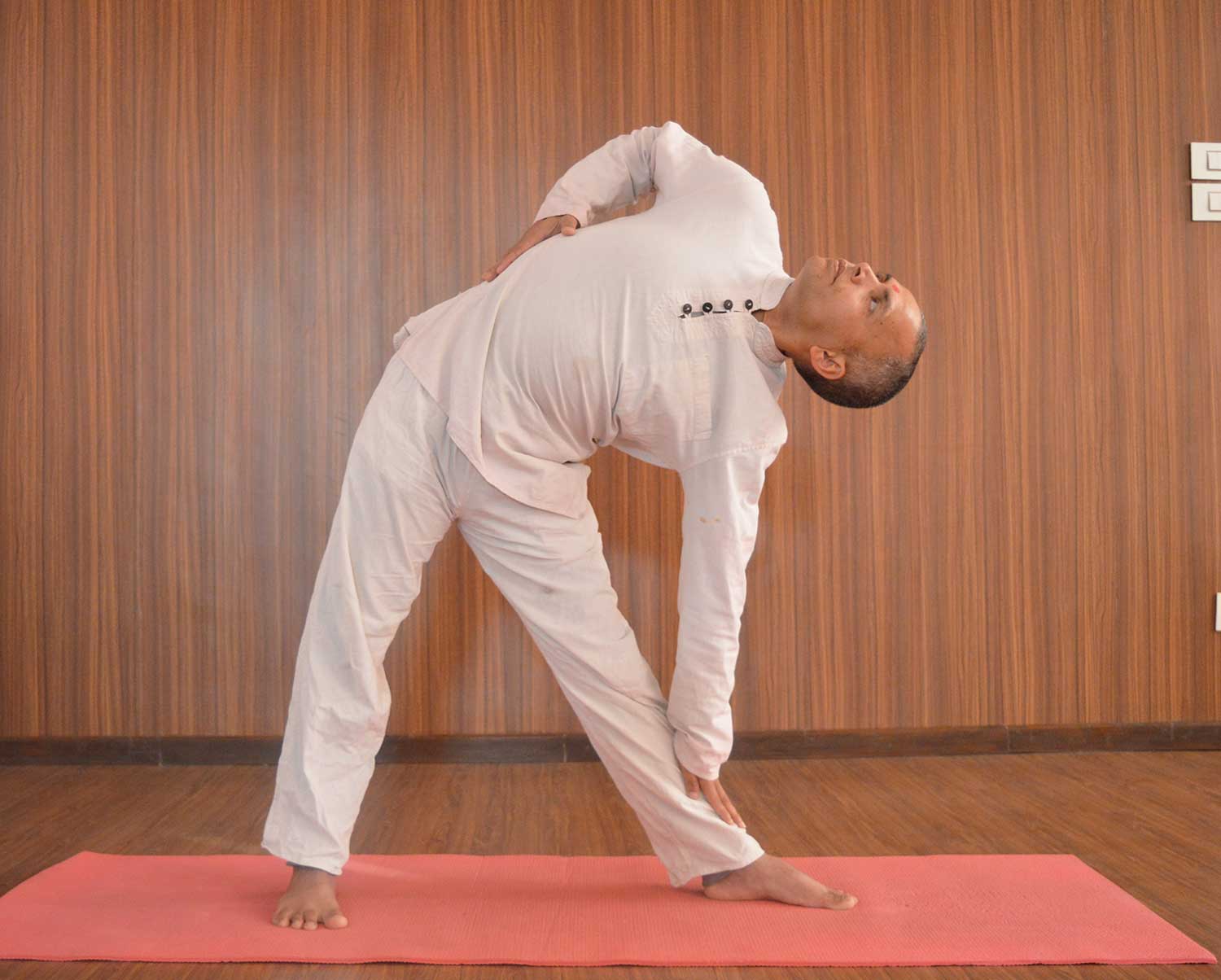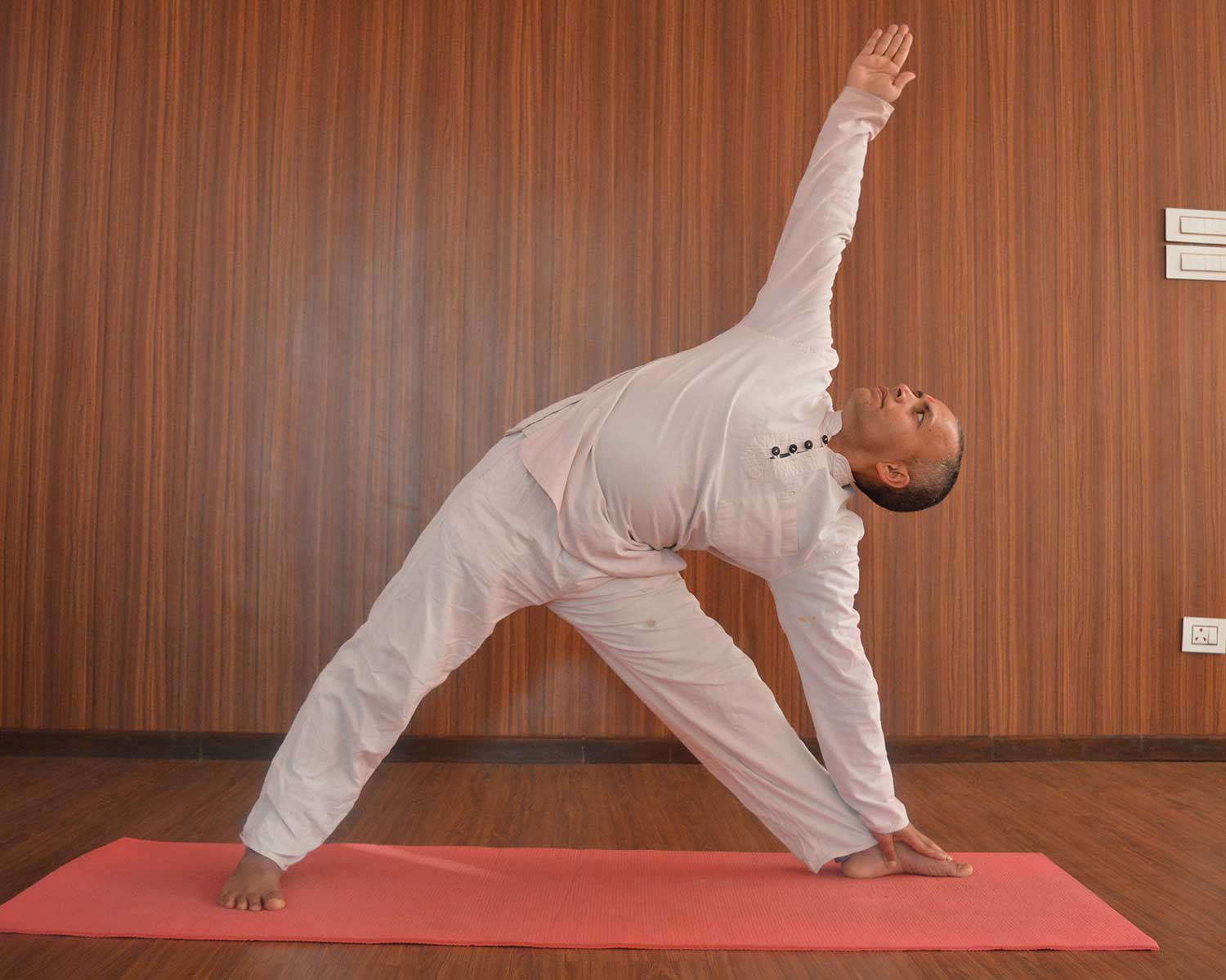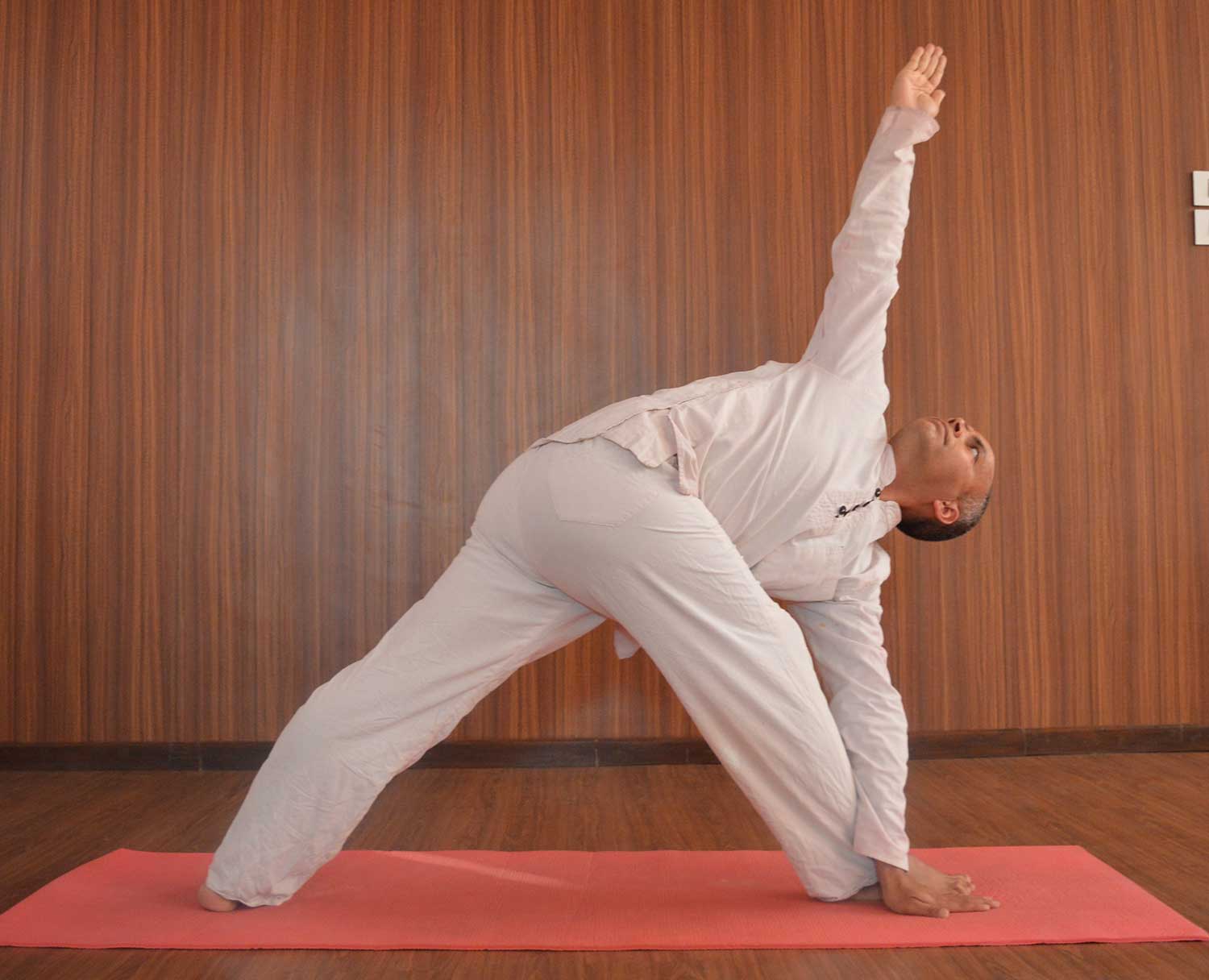TRIKONASANA (TRIANGLE POSE)
19 Jan 2021 HYN Himalayan Yoga Academy

TRIKONASANA (TRIANGLE POSE)
The term Trikonasana त्रिकोणासन comes from the Sanskrit trikona, meaning “three corners” or “triangle,” and asana, meaning “posture.” The term is often used synonymously with utthita trikonasana (extended triangle pose).
Trikonasana is a standing yoga posture that requires strength, balance and flexibility. In this posture, both arms extend with the legs spread apart and one foot turned at a 90-degree angle. The upper body bends toward the lead foot so that one arm reaches toward, but not necessarily touching, the ground and the other toward the sky.
Methods :
Stand straight. Separate your feet comfortably wide apart (about 3 to 4 feet).
Turn your right foot out 90 degrees and left foot in by 15 degrees.
Now align the center of your right heel with the center of your arch of left foot.
Ensure that your feet are pressing the ground and the weight of your body is equally balanced on both the feet.
Inhale deeply and as you exhale, bend your body to the right, downward from the hips, keeping the waist straight, allowing your left hand to come up in the air while your right hand comes down towards floor. Keep both arms in straight line.
Rest your right hand on your shin, ankle, or the floor outside your right foot, whatever is possible without distorting the sides of the waist. Stretch your left arm toward the ceiling, in line with the tops of your shoulders. Keep your head in a neutral position or turn it to the left, eyes gazing softly at the left palm.
Ascertain that your body is bent sideways and not backward or forward. Pelvis and chest are wide open.
Stretch maximum and be steady. Keep taking in long deep breaths. With each exhalation, relax the body more and more. Just be with the body and the breath.
As you inhale, come up, bring your arms down to your sides, and straighten your feet.
Repeat the same on the other side.
Variations of Trikonasana
- Sarala Trikonasana

- Trikonasana

- Utthita Trikonasana
- Parivrtta Trikonasana
3. Utthita Trikonasana

The name Utthita Trikonasana उत्थित त्रिकोणासन; comes from the Sanskrit utthita, meaning “extended,” trikona, meaning “three corners” or “triangle,” and asana, meaning “pose.” The term is often used synonymously with trikonasana (triangle pose). The common English name for Utthita Trikonasana is Extended Triangle Pose.
Uttihita trikonasana is a standing yoga asana that requires balance and flexibility. In this posture, straight legs are spread apart and one foot is at a 90-degree angle. With both arms extended, the body bends toward the lead foot so that one arm reaches toward the ground and the other toward the sky. In addition to a range of physical benefits, uttihita trikonasana is believed to stimulate energy pathways in the body.
4. Parivrtta Trikonasana
Parivrtta Trikonasana is an Asana Yoga pose. It is translated as Revolved Triangle Pose from Sanskrit, the name of this pose comes from parivrtta meaning revolved, tri meaning three, kona meaning angle and asana meaning posture or seat. This pose is a variation of Trikonasana or Triangle Pose.
Technique of Parivrtta Trikonasana
To begin the Parivrtta Trikonasana asana, stand in Tadasana (or mountain pose), i.e. feet together, toes touching and hands by your side. Exhale and jump with your feet, 3-4 feet apart.
Raise your arms parallel to the mat. They should be in the line with your shoulder and be facing down.
Turn your right foot 90 degrees to the right & left foot 45 degrees to your right. Make sure your left and right heels are aligned and turn your right thigh outward.

Slowly turn to your right, exhale and bend down in front of your right leg and touch the floor with your left hand. Inhale and raise your right arm up towards the ceiling. You can even use the “yoga -block” for the support, if you are unable to touch the floor. Turn your head up and look at the thumb of the raised hand. Make sure your neck is in a comfortable position.
The Benefit of Practicing Trikonasana :
- This exercise helps to strengthen and stretches the legs.
- It stretches the hip and spine and increases flexibility.
- This exercise expands the chest and shoulders and removes the stiffness of neck and Beneficial in correcting the misalignment of the shouldersStrengthens the legs, knees, ankles, arms and chestStretches and opens the hips, groins, hamstrings, calves, shoulders, chest and spineIncreases mental and physical equilibriumIt stretches spinal muscles and increases the spinal range of motion.
- This exercise helps to increases neck mobility.
- It helps the body to inhale fresh oxygen and nutrients and helps improve digestion
- Revitalize abdominal organs hence helpful in getting rid of digestive problems and constipation.
- It Strengthens and tones the muscles of the thighs, back pain and sciatica
- Stretches calf muscles, thigh, hamstrings and hip muscles
- It improves the sense of balance by keeping the feet and ankles in space.
- Massages reproductive organs and pelvic region of the body.
- Gives an intense stretch to the spine and enhances its flexibility.
- Strengthens spinal nerves and it helps to relieve upper back tension and reduces anxiety, and stress.
- Directs the blood flow in the lower region of the spine improving its functioning
Preparatory asanas to do before Trikonasana
- Tadasana
- Triyak Tadasana
- Katichakrasana
- Konasana
- Vrikshasana
Precautions:
While performing the Parivrtta Trikonasana, there are a few things that you should keep in mind:
If you have a spine or back injury then you are advised to do this yoga asana under the expert supervision of an experienced yoga teacher.
Students with problems like migraine, low blood pressure, headache, diarrhoea should also avoid doing this yoga asana.
Learn these poses with our experienced teachers of Himalayan Yoga Academy, our academy provides 200 hour & 300 Hour Yoga Teacher Training Courses,as RYT200 Yoga Certification offers detailed teachings on asana’s (Yoga Postures), meditation, Pranayama, yoga philosophy, yoga anatomy physiology, alignment-adjustment, teaching methodology as well as fundamentals of Ayurveda and its importance.Our experinced teachers of Yoga School, like Swami Yog Subodh , will surely guide your path with different knowledge and skills.
